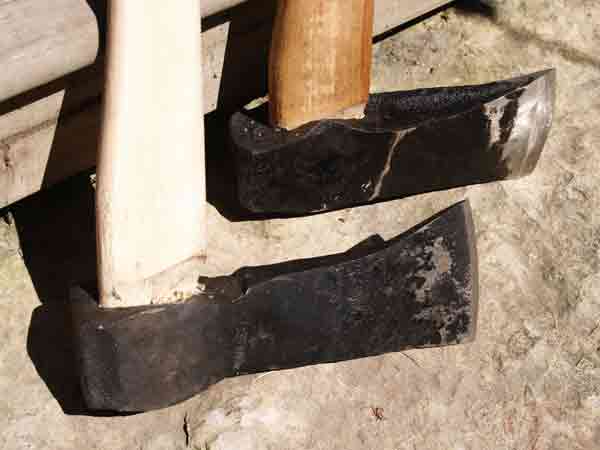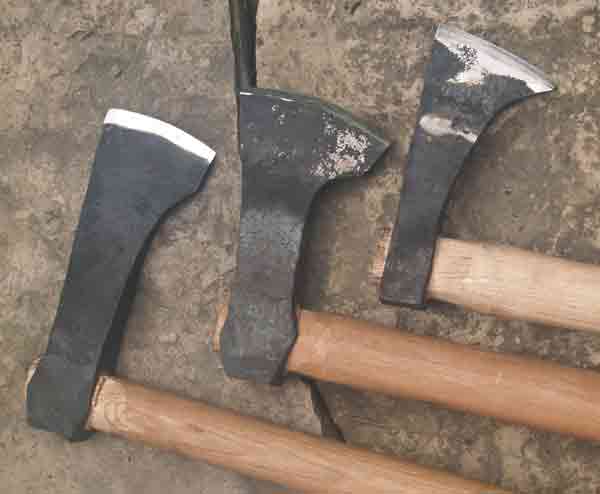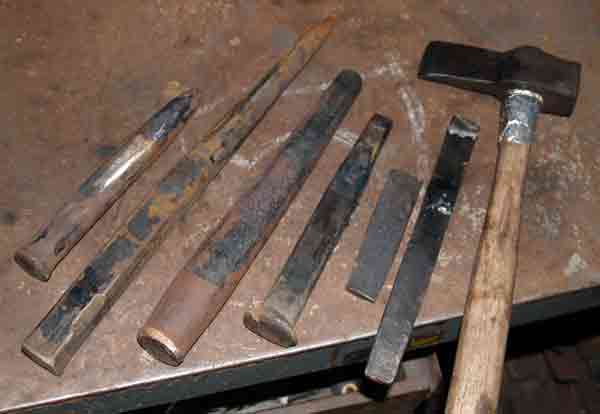These are the various axes as they were completed. Through my own research, valuable insight from the Viking Ship Museum at Roskilde (detailed HERE), plus conversations with the staff at LAM, the following tools were agreed upon:

First it was determined there should be two heavier axes intended for raw timber processing. One is a felling axe with a long slender cross section (for better penetration). This head is 22 cm long with a 9 cm blade and weighs 2.25 KG. The second is a splitting axe, with a much wider wedge shape. This head is 19 cm long with a 8 cm blade and weighs 2.5 KG. The splitting axe was the first one I made up, and unlike the others is forged from a single piece of mid carbon spring steel (I had the material on hand). The starting stock for both of these axes was 1 1/2 x 2 inch bar.

The next set of axes are for shaping of the cut timbers. They are all lighter and have much longer tapers to the cross section. The image shows (L - R) the 'fine axe' based on one from the Mastermyr tool box. The head is 20.5 cm long and 8 cm wide and weighs 1.45 KG. (The original axe is somewhat lighter in construction - at 22 x 7 cm / 750 gm.) Next is based on a find from Dejbejerg Denmark (see below). Last is a 'light hatchet' based on an artifact at the Ribe Viking Museum. The head here is 17 cm long with an 8 cm blade and weight of 900 gm and is mounted on a shorter handle.

The Dejbejerg axe is branded 'Tom's Favorite' - a personal recommendation of one of the master shipbuilders at Roskilde. In this case the measurements are based on a modern replica, rather than an original artifact. My reference here was an excellent quality working tool produced by Danish blacksmith Aage Frederiksen (who has made most of the tools used at the Viking Ship Museum). My version is 18 cm long with a 10 cm blade at a weight of 920 gm.

All of the axes are forged using solid mild steel bars with punched eyes, the method used for all Viking Age artifacts. For some of the heads, a slit was made first, on the lighter tools a small oval punch was used initially. A combination of various tapered drifts were then used to create the final shape of the eye. (Settlement era axes are made of folded and welded flat stock, which gives a distinctive tear drop shape to the eye.) In most cases the sides of the eyes have been drawn out to produce the distinctive 'ears' common to many VA axes. Save for the splitting axe, all the tools have lap welded (one side) carbon steel cutting edges. The result is a tool that is both tough but will maintain a good working sharpness.
It was decided to use standard (and easily available) commercial handles for the axes to permit easy replacement as required. The two timber cutting axes use a 'straight axe handle', the shaping axes all use a more oval '32 inch sledge' handle. (Both purchased at your local Home Hardware.)
I have also been shooting a photo essay series for the creation of the two most complex of the forgings : the Mastermyr adze and the Bayeux broadaxe. I also hope to produce a short video segment on the Bayeux broadaxe - stay tuned!




















1 comment:
That 1.5 by 2 inch bar stock...is that the "trade iron" size you mentioned?
Post a Comment